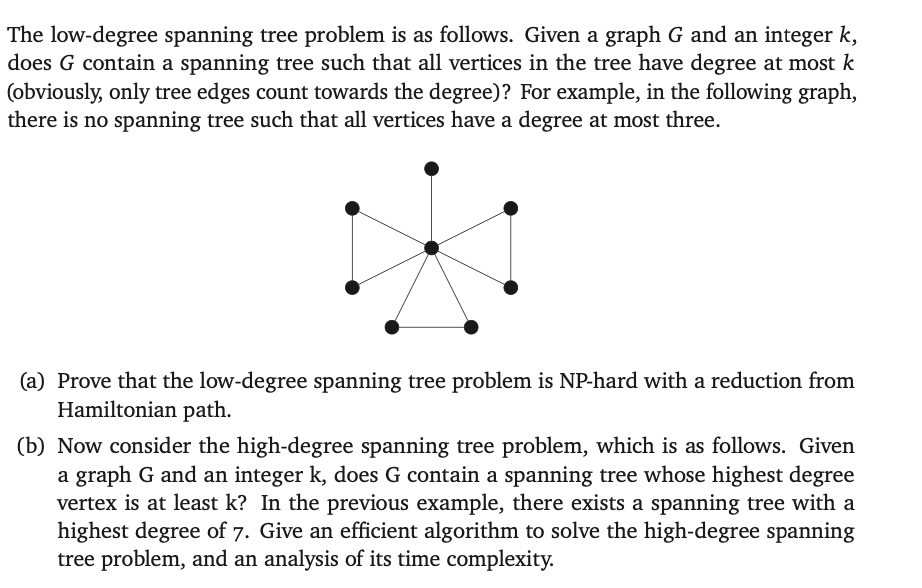The low-degree spanning tree problem is as follows. Given a graph G and an integer k, does G contain a spanning tree such that all vertices in the tree have degree at most k (obviously, only tree edges count towards the degree)? For example, in the following graph, there is no spanning tree such that all vertices have a degree at most three. (a) Prove that the low-degree spanning tree problem is NP-hard with a reduction from Hamiltonian path. (b) Now consider the high-degree spanning tree problem, which is as follows. Given a graph G and an integer k, does G contain a spanning tree whose highest degree vertex is at least k? In the previous example, there exists a spanning tree with a highest degree of 7. Give an efficient algorithm to solve the high-degree spanning tree problem, and an analysis of its time complexity.
The low-degree spanning tree problem is as follows. Given a graph G and an integer k, does G contain a spanning tree such that all vertices in the tree have degree at most k (obviously, only tree edges count towards the degree)? For example, in the following graph, there is no spanning tree such that all vertices have a degree at most three. (a) Prove that the low-degree spanning tree problem is NP-hard with a reduction from Hamiltonian path. (b) Now consider the high-degree spanning tree problem, which is as follows. Given a graph G and an integer k, does G contain a spanning tree whose highest degree vertex is at least k? In the previous example, there exists a spanning tree with a highest degree of 7. Give an efficient algorithm to solve the high-degree spanning tree problem, and an analysis of its time complexity.
Related questions
Question

Transcribed Image Text:The low-degree spanning tree problem is as follows. Given a graph G and an integer k,
does G contain a spanning tree such that all vertices in the tree have degree at most k
(obviously, only tree edges count towards the degree)? For example, in the following graph,
there is no spanning tree such that all vertices have a degree at most three.
(a) Prove that the low-degree spanning tree problem is NP-hard with a reduction from
Hamiltonian path.
(b) Now consider the high-degree spanning tree problem, which is as follows. Given
a graph G and an integer k, does G contain a spanning tree whose highest degree
vertex is at least k? In the previous example, there exists a spanning tree with a
highest degree of 7. Give an efficient algorithm to solve the high-degree spanning
tree problem, and an analysis of its time complexity.
Expert Solution
This question has been solved!
Explore an expertly crafted, step-by-step solution for a thorough understanding of key concepts.
This is a popular solution!
Trending now
This is a popular solution!
Step by step
Solved in 2 steps
